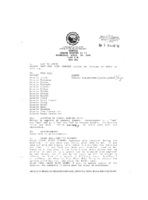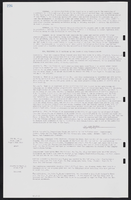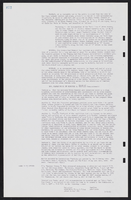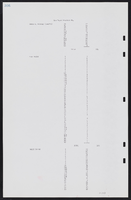Search the Special Collections and Archives Portal
Search Results

Meeting minutes for Consolidated Student Senate University of Nevada, Las Vegas, Arpil 29, 1992
Date
1992-04-29
Archival Collection
Description
Includes meeting agenda and minutes with additional information about senate bills.
Text
Katherine Neddenriep (Elko Convention and Vistors Authority) oral history interview conducted by Kelliann Beavers: transcript
Date
2022-07-13
Archival Collection
Description
From the Lincy Institute "Perspectives from the COVID-19 Pandemic" Oral History Project (MS-01178) -- Business interviews file.
Text

Transcript of interview with Myrna Williams by Suzanne Becker and Joanne L. Goodwin, April 16, 2008
Date
2008-04-16
Archival Collection
Description
Myrna Williams was born in Chicago in 1929. Her brother was the singer Mel Tormé, so the family moved to Hollywood when she was ten because her brother was under contract with MGM. Shortly after Myrna turned 21, she moved to New York to work for Decca Records. She met the jazz drummer David Williams, whom she married. Myrna, David, and their daughter Indy moved to Las Vegas in 1959. Myrna got involved in politics, and was elected to the Nevada State Assembly and to the Clark County Commission. She also taught in the University of Nevada, Las Vegas' department of social work for eleven years. Myrna is also a member of numerous community organizations and sits on the board of the Public Education Foundation and the Anti-Defamation League. Her greatest accomplishment in her opinion is the development of the Cambridge Recreation Center, a community center that houses a skate park and a pool, as well as programming that focuses on at risk youth. In 2007 it was designated as the Myrna Tormé Community Campus.
Text

Transcript of interview with Vernon Caples by Cheryl Caples, February 25, 1979
Date
1979-02-25
Archival Collection
Description
Narrator b.1891. Las Vegas history from 1942 to 1979. Las Vegas airfield (Nellis). Prostitution. Hoover (Boulder) Dam: two anecdotes. Effect of WWII on Las Vegas. Hotel/casinos during the 1940s and 1950s. Leisure activities. Eldorado Festival. Lorenzi Park. BMI Plant. Retirement in Las Vegas.
Text

Transcript of interview with John F. Cahlan by Radmila Radovich, February 27, 1980
Date
1980-02-27
Archival Collection
Description
John Cahlan (1902-1988) is interviewed by Radmila Radovich about the beginning of Las Vegas, including the role of the Union Pacific Railroad and its need for water. Cahlan discusses the changes in Las Vegas over time, including the evolution of the Western Air Express station to Nellis Air Force Base, as well as his concerns for the future of Las Vegas.
Text

Transcript of interview with Charles A. Bennett by Michael Kulwin, March 5, 1979
Date
1979-03-05
Archival Collection
Description
Michael E. Kulwin interviews co-worker Charles A. Bennett (b. 1914) at his home. Bennett discusses early gaming figures, real estate, Howard Hughes, and casino development. Bennett also weighs in on the Carol Lombard plane crash tragedy, and the early atomic bomb tests conducted in Nevada.
Text
Pagination
Refine my results
Content Type
Creator or Contributor
Subject
Archival Collection
Digital Project
Resource Type
Year
Material Type
Place
Language
Records Classification




